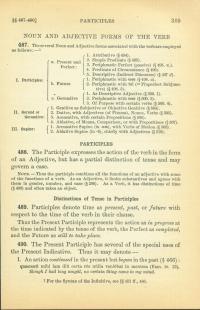487. The several noun and adjective forms associated with the verb are employed as follows.1
| I. Participles: | a. Present and Perfect: | 1. Attributive (§ 494) |
| 2. Simple Predicate (§ 495). | ||
| 3. Periphrastic Perfect Passive) (§ 495, Note) | ||
| 4. Predicate of Circumstance (§ 496) | ||
| 5. Descriptive (Indirect Discourse) (§ 497.d) | ||
| b. Future | 1. Periphrastic with esse (§ 498.a) | |
| 2. Periphrastic with fuī ( = Pluperfect Subjunctive) (§ 498.b) | ||
| c. Gerundive | 1. As Descriptive Adjective (§ 500.1) | |
| 2. Periphrastic with esse (§ 500.2). | ||
| 3. Of Purpose with certain verbs (§ 500.4). | ||
| II. Gerund or Gerundive: | 1. Genitive as Subjective or Objective Genitive (§ 504). | |
| 2. Dative, with Adjectives (of Fitness), Nouns, Verbs (§ 505) | ||
| 3. Accusative, with certain Prepositions (§ 506). | ||
| 4. Ablative, of Means, Comparison, or with Prepositions (§ 507) | ||
| III. Supine: | 1. Accusative Supine (in -um), with Verbs of Motion (§ 509) | |
| 2. Ablative Supine (in -ū), chiefly with Adjectives (§ 510). | ||
Footnotes
XML Files

